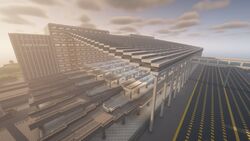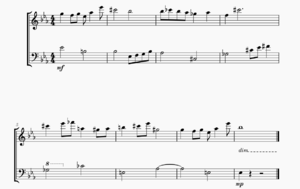Difference between revisions of "Misato Station"
Views
Actions
Namespaces
Variants
Tools
Micahmouse (talk | contribs) |
Micahmouse (talk | contribs) |
||
| Line 412: | Line 412: | ||
| | | | ||
|- | |- | ||
|Vtuber Park Line | |{{Route|cc6c6c|[[Vtuber Park Line]]}} | ||
|4 | |4 | ||
|Sky High | |Sky High | ||
| Line 419: | Line 419: | ||
|This tune would only play once before departure instead of twice. | |This tune would only play once before departure instead of twice. | ||
|- | |- | ||
|Ai Liner | |{{Route|ffbaba|[[Ai Liner]]}} | ||
|5 | |5 | ||
|Hello Morning | |Hello Morning | ||
| Line 426: | Line 426: | ||
|This tune would only play once before departure instead of twice. | |This tune would only play once before departure instead of twice. | ||
|- | |- | ||
|[[Hakone Express]] | |{{Route|#2d8c55|Limited Express [[Hakone Express|''Hakone'']]}} | ||
|6 | |6 | ||
|A Hakone Folk Tune | |A Hakone Folk Tune | ||
| Line 433: | Line 433: | ||
|This tune would only play once before departure instead of twice. | |This tune would only play once before departure instead of twice. | ||
|- | |- | ||
|Ome Liner | |{{Route|#FC03DB|Limited Express [[Ome Liner|''Ome Liner'']]}} | ||
|7 | |7 | ||
|HRT-LT2 | |HRT-LT2 | ||
| Line 440: | Line 440: | ||
| | | | ||
|- | |- | ||
|Kansai Main Line | |{{Route|#c4833d|[[Kansai Main Line]]}} | ||
|8-10 | |8-10 | ||
|HRT-LT3 | |HRT-LT3 | ||
| Line 469: | Line 469: | ||
| | | | ||
|- | |- | ||
|Yamate Line | |{{Route|#a1eb34|[Yamate Line]}} | ||
|19,20 | |19,20 | ||
|HRT-LT7 | |HRT-LT7 | ||
| Line 476: | Line 476: | ||
| | | | ||
|- | |- | ||
|Sakuho Line | |{{Route|8240a|[[Sakuho Line]]}}|21,22 | ||
|21,22 | |||
|HRT-LT6 | |HRT-LT6 | ||
| | | | ||
Revision as of 20:37, 30 April 2022
| Location | 1552 ~ 31943 |
|---|---|
| Owned by | Harmony Rail Transit (Lamtsu) |
| Operated by | Harmony Rail Transit (Lamtsu) Misato Rapid Transit Kabuki Kaisha (MRT Corp) |
| Line(s) | Yamate Line Mihara Line |
| Platforms | 13 |
| Tracks | 13 |
| Connections | MRT Misato Station Misato Light Rail Stop |
| Structure Type | At-Grade+Elevated |
|---|---|
| Platform Levels | 3 |
| Disabled Access | No |
| Station Code | MS |
|---|
| Opened | 30 June 1947 (Initial Opening)
1st May 2022 (Heritage Platforms) 30 June 2022 (Full Reopening) |
|---|---|
| Closed | 31st Jan 2022 (Reconstruction) |
Misato Station is a HRT (Lamtsu) station in Misato City, Lamtsu Capital City, Hon Kwong Province, Federation of Sorano. It forms the city's main rail terminal in the north.
Although it is only officially served by the Mihara, Namboku, Yamate and Ome Lines, Misato is the starting point for most of the major Limited Express trains to and from Lamtsu, as well as being a station on the Sakuho-Kujukuri Line. It is also the de facto terminus of the Mihara Line (local), and Yamate Line trains officially start and end their service here.
SMRT Misato Station (Kansai Main Line, Sakuho Line), Misato Central Light Rail Station (Misato City Tram) and Sora Station (Heritage Ome Line) are directly connected to Misato Station, with the 3 stations together expected to average similar numbers to the original. The Misato Bus Terminal used to operate opposite the Station until the bankruptcy of Misato City Railway, after which bus services stopped operating in Lamtsu.
The Station was the most important station in the HRT Network in Lamtsu, being the primary terminus for long-distance lines to Joban and South-East Sorano, although this role has diminished somewhat with the opening of the Shinkansen Lines at Lamtsu station. It was also the 3nd busiest Station in the Joban-Sorano Region, with more than 700,000 commuters using the station in June 2016 (boarding passengers only)
Misato Station used to be adjacent to Misato Frieght Terminal, adjacent to the Station and connected to the Misato Frieght Line, Ome Line and Mihara Line. The station was demolished in 2022 to make way for the Misato Central Mall.
The station was closed for reconstruction after the HRT (Lamtsu) scandals that followed the 2022 Sora train wreck, with many of the Main Lines being rerouted away from the station and the Kansai Main Line being split off to the MRT Corporation.
General Information
Lines
More Lines can be found at MRT Misato Station across the street.
Station Layout
Misato Station is elevated above street level, on the second floor of the station complex. There are 8 exits, split between 2 concourses. Exits A through D are located on the concourse on the ground floor, and generally are used for normal entry and exit. These sets of gates are referred to as the Misato Gates by locals and staff, although they are officially referred to as the Ground Level Gates. Exits E through G are located on the Bridge Concourse, and the exit gates here are similarly named the Bridge gates. These sets of gates (excluding exit E) are usually used to transfer to the SMRT Station, be it for the Misato City Tram or the Kansai Main Line. The Sakuho Gates at exit H lead directly to the stairs for the Sakuho Line platforms. Officially part of SMRT Misato Station, this stop does not show up more than once on the MRT maps despite it stopping twice. Proposals have been made to expand the Bridge Concourse to a second platform level, to accommodate future North-South traffic with the proposed Lamtsu-Misato Line, which is a viaduct over the existing six-track section.
Platforms and Tracks are on the first floor. The initial plans called for 6 island platforms serving 12 tracks, but with the rerouting of the Vtuber Park Line to Kimotsuki, this was later reverted to 5. The previous Misato Station Public Carpark was demolished to make was for the Misato Central Mall, which is located on the left of the station. All platforms offer through services excluding the Ome Line platforms, which terminate here. A proposal has been made to build new tracks for the Ome Line using viaducts so that they could be straighter, from Misato to Mihara, to run express services.
Under Construction
The Lamtsu-Mihara Viaduct is the planned construction of a viaduct that would link the stations of Lamtsu, Misato and Mihara with newly built straight track that would facilitate limited express services from the north and south. The proposal was approved, abeit with slight modifications to the initial stage. The Ome Line will use the viaduct from Misato to Mihara in the first stage to run Ome Liner services at 160km/h, the fastest service in the region. No changes will be made to the existing Ome Line plans, which will utilise the old Misato Frieght Line tracks for the current plan.
Exits
- A: Misato Central Mall
- B: Misato Central Plaza
- C: Misato High Street
- D: Ome Railway Museum
- E: Misato Central Mall Level 4
- F: Opposite Misato Station
- G: SMRT Misato Station
- H: Sakuho Exit
Passenger Statistics
In 2020, 745,872 commuters used the station daily on average, making it the busiest station in the Harmony Rail Transit (Lamtsu) Network. It is estimated that this figure will decline significantly after the rebuild.
| Fiscal Year | Passenger Number |
|---|---|
| 2013 | 687,109 |
| 2014 | 693,092 |
| 2015 | 699,867 |
| 2016 | 702,345 |
| 2017 | 713,298 |
| 2018 | 724,983 |
| 2019 | 737,182 |
| 2020 | 745,872 |
| 2021 | 752,127 |
| 2022 (projection) | 503,198 |
Platforms
Harmony Rail Transit
The HRT platforms are all located on the first floor, with all of them being Island platforms. Escalator and Stair access is available, although Lifts for disabled access have been planned.
HRT Platforms
| L1 | |||
|---|---|---|---|
| 1 | Mihara Line (Express) | For Mihara | |
| Mihara Line (Suburban) | For Mihara, Hayakawa | ||
| Limited Express ''Tsuwano'' | For Tsuwano Sports Hub | ||
| 2 | Mihara Line(Express) | For Lamtsu, Yamate | |
| Mihara Line (Suburban) | For Lamtsu | ||
| 3 | Mihara Line (Local) | For Sasaguri, Mihara, Tai Hing Forest | |
| Mihara Line (Rapid) | For Mihara, Otaki, Hakone | ||
| 4 | Mihara Line(Local) | For Lamtsu | |
| Mihara Line (Rapid) | For Hakone, Tai Hing Forest | ||
| 5 | Namboku Line | For Fukaaura, Hayakawa | |
| Namboku Line (Ome Line Through Service) | For Hayakawa, Kusu | ||
| 6 | Namboku Line | For Lamtsu, Meguro | |
| 7 | Yamate Line | Soto-Mawari for Nakagawa, Otaki, Lamtsu | |
| 8 | Yamate Line | Uchi-Mawari for Lamtsu, Otaki, Hikawa | |
| 9 | Ome Line | For Shirakao, Hayakawa, Kusu | |
| Ome Line (Rapid) | For Shirakao, Mihara, Hayakawa | ||
| Limited Express Hakone | For Hakone | ||
| Limited Express Sunrise Yamagawa | For Ome | ||
| 10 | Limited Express Ome Liner | For Hayakawa, Ome | |
| Limited Express Tokiwa | For Ome, Central South | ||
| Limited Express Shimakaze | For Ome, Sung Tak |
Limited Express Trains
For the Mihara Line
Limited Express Hakone (Misato-Hakone)
Limited Express Tsuwano (Lamtsu-Misato-Tsuwano Stadium)
For the Ome Line
Commuter Limited Express Ome Liner (Misato-Mihara-Hayakawa-Ome)
Limited Express Tokiwa (Misato-Mihara-Ome-Central South)
Limited Express Shimakaze (Misato-Ome-Sung Tak)
Limited Express Sunrise Yamagawa (See Article)
Misato Rapid Transit
The Sakuho Line platforms under Misato Station are located in the centre of the station.
MRT Platforms
| B1 | |||
|---|---|---|---|
| 11 | Sakuho Line for MRT Misato Station, Kamiyama | ||
| 12 | Sakuho Line for Moseushi |
Adjacent Stations
| « | Service | » | ||
|---|---|---|---|---|
| Mihara Line | ||||
| Lamtsu | Mihara Line Local | Sasaguri | ||
| Lamtsu | Mihara Line Rapid | Tsuwano | ||
| Lamtsu | Mihara Line Express | Mihara | ||
| Lamtsu | Mihara Line Suburban | Mihara | ||
| Terminus | Limited Express Hakone | Hakone | ||
| Lamtsu | Limited Express Tsuwano | Tsuwano Sports Hub | ||
| Namboku Line | ||||
| Kimotsuki | Namboku Line | Nyuzen | ||
| Kimotsuki | Namboku Line (Ome) | Nyuzen | ||
| Yamate Line | ||||
| Kimotsuki | Yamate Line | Hikawa | ||
| Ome Line | ||||
| Shirakao | Ome Line (Urban) | Terminus | ||
| Shirakao | Ome Line (Rapid) | Terminus | ||
| Terminus | Limited Express Ome Liner | Mihara | ||
| Terminus | Limited Express Tokiwa | Ome | ||
| Terminus | Limited Express Shimakaze | Ome | ||
| Tai Hing Forest | Sunrise Yamagawa | Mihara | ||
| Sakuho Line | ||||
| Moseushi | Sakuho Line | Goka |
Departure Melodies
Misato Station was the first station in the district of Joban to use Departure Melodies, and still is the only station that uses them to this day. Departure Melodies have not yet been confirmed for the new station.
| Service | Platform Number | Tune Name | Tune | Score | Details |
|---|---|---|---|---|---|
| Ome Line(Local) | 1 | HRT-LT1(a) | |||
| Ome Line (Rapid) | 2 | HRT-LT1(b) | |||
| Ome Line (Urban) | 3 | HRT-LT1(c) | |||
| Vtuber Park Line | 4 | Sky High | This tune would only play once before departure instead of twice. | ||
| Ai Liner | 5 | Hello Morning | This tune would only play once before departure instead of twice. | ||
| Limited Express Hakone | 6 | A Hakone Folk Tune | This tune would only play once before departure instead of twice. | ||
| Limited Express Ome Liner | 7 | HRT-LT2 | |||
| Kansai Main Line | 8-10 | HRT-LT3 | |||
| Mihara Line(Express) | 11,12,17,18 | HRT-LT4(b) | |||
| Namboku Line | 13,16 | HRT-LT5 | |||
| Mihara Line(Local) | 14,15 | HRT-LT4(a) | |||
| [Yamate Line] | 19,20 | HRT-LT7 | |||
| Sakuho Line |21,22 | HRT-LT6 |
History and Technical Details
History
Conception
Misato Station was originally conceived as the terminus of the Yamate Line in 1946. However, pressure from the local government forced the extension of the Line to Hikawa, delaying its opening by a year. The original station was constructed at-grade, with the Yamate Line platforms adjacent to Misato Hill.
Further Expansion
With the opening of the Namboku Line in 1968 and the Completion of the Kujukuri-Sakuho Line in 1975, Misato Station replaced Lamtsu station as the de facto primary interchange. however, Misato City Railway maintained that Lamstu station was the main terminus, making it the de jure interchange and therefore received the bulk of the funding. This resulted in the infrastructure of Misato Station being very lacking.
Subsequent platforms were built on a separate station building and elevated, for the terminating 4-car lines on ground level. However, the lack of funding and the prohibitive land costs in Misato prompted the platform width to be reduced from the 10m standard on the Yamate Line to 5 metres for the elevated platforms. By 2015, Misato Station was severely overcrowded, with reports of suffocations due to lack of platform space being not uncommon. This was further exasperated due to the cross-platform transfers between the Mihara and Namboku lines, where crowds of passengers would often crush each other in an attempt to squeeze onto the trains. By this time, almost every line would pass through or terminate at Misato, excluding the Tozai Line and the Chuo Main Line. As the Chuo Main Line was built by HRT and not Misato City Railway (Now MRT), the Line was prohibited from cutting across the Yamate Line and the decision was made for it to terminate at Otaki, with some services continuing to Fukaaura.
2022 Sora Train Wreck
The 2022 Sora Train wreck was the worst train accident in all of Sorano, with 78 fatalities and more than 600 injured. The train involved was a Ome Liner limited express on the stretch between Sora and Misato.
Preliminary investigations show that the train was travelling at 120km/h over a 60km/h stretch, and as such the train derailed and broke apart while approaching the bend towards Misato station.
The driver was most likely trying to make up for lost time that had occurred when he overran the platform at Mihara, causing the train to be delayed by 5 minutes, and then delayed again because he was slowed down by a Vtuber Park Line Local train also travelling to Misato. The extremely old and curvy tracks on the lines in Lamtsu had been a severe issue for quite a while, with a 2018 report highly recommending the rebuilding of the old lines. However, these warnings were ignored and the speed limits on the lines were in some parts, cranked up all the way to 160km/h on what should have been a 100km section at the maximum.
The accident triggered an investigation that found HRT (Lamtsu) guilty of negligence and filed an antitrust lawsuit, splitting the company into 3. This also caused the 2022 Great Lamtsu Railway Rebuild, a period of 8 months without train service where the railways were being rebuilt.
2022 Misato Station Rebuild
In the aftermath of the Sora Train Wreck, HRT Lamtsu had a revision of the railroad doctrine, and the decision was made to spread out the terminals of the lines along the Yamate Line rather than concentrating them all along Misato station. The Vtuber Park Line was moved to Kimotsuki, and the Kansai Main Line was moved to MRT Misato station across the road. Tram operations also were moved to terminate at the new Misato Tram terminal.
Misato's old stone-brick design, while nostalgic, was not kept in the rebuild. Misato station was completely transformed from an overcrowded dinky station to a modern, futuristic station. The Engineer and Architect of the station was subsequently put in charge of the Lamtsu Railways. However, despite this amount of responsibility, he was still officially a minor employee and thus drew a very low salary, leading to accusations at HRT of Black Company behavior.
The reconstruction of Misato Station took place in a set of stages:
- Demolition of the old Misato Station and Misato Frieght Terminal
- Encasing the old Sakuho Line platforms in concrete before starting other works
- Constructing the foundation of the station
- Constructing the platforms and laying the ballast
- Constructing Misato Central Mall
- Constructing the cover over the station
- Connecting the platforms to the railroad
- Finishing Touches
The entire process took less than a year, due to the immense amounts of manpower invested to complete the station in record time. At least 500,000 construction workers were involved in the process.
Platform Layout Pre-Reconstruction
| B1 | |
| 21: Sakuho Line for Kamiyama (From the Kujukuri Line)→ | |
| Island Platform (To Concourse) | |
| ←22: Kujukuri Line for Tsubetsu (from the Sakuho Line) |
| G (Indoors) | |
| Side Platform | |
| 1: Ome Line (Urban) | |
| 2: Ome Line (Rapid) | |
| Island platform | |
| 3: Ome Liner | |
| 4: Ai Liner | |
| Island Platform | |
| 5. Vtuber Park Line | |
| 6. Kansai Main Line (Local) | |
| Island Platform | |
| 7. Kansai Main Line (Rapid) | |
| 8. Kansai Main Line (Express) | |
| Island Platform | |
| 9. Kansai Main Line (Urban) | |
| 10. Tohoku Liner | |
| Side Platform |
| G | |
| 19. Yamate Line (Soto-Mawari)→ | |
| Island Platform | |
| 20. ←Yamate Line (Uchi-Mawari) |
| L1 | |
| Side Platform | |
| 11. Mihara Line for Hayakawa→ | |
| 12: Mihara Line for Tai Hing→ | |
| Island Platform | |
| 13. Namboku Line for Hayakawa→ | |
| Island Platform | |
| 14. Mihara Line for Mihara→ | |
| ←15. Mihara Line for Yamate | |
| Island Platform | |
| ←16. Namboku Line for Meguro | |
| Island platform | |
| ←17. Mihara Line for Lamtsu | |
| ←18. Mihara Line for Lamtsu | |
| Side Platform (Connect to Yamate Line) |
Design
Misato Station is a modernist style, with a huge roof covering 5 Island platforms, with the concourse at ground level. An elevated linkway above the platforms connects them directly to the opposite side of Misato High Street, as well as Misato Central Mall and MRT Misato station. On the map, the colour of the station is grey, but the colour scheme of the area is much more light-blue. The concourse preserves the older andesite grey colour scheme, while the floor of the concourse is a tiled pattern alternating Polished Diorite and Calcite. On the North-West of the station, there is a heritage area in the style of the old Misato Station for the heritage Ome Line. The Sakuho-Kujukuri Line platforms retain their old design.
Misato Station has no station building, instead opting for a ground-level concourse with elevated platforms. Ticketing offices can be found on the outside of the station, and within the Misato Central Mall.
The old Misato Station was very much brutalist architecture, with the station constructed of mostly Stone Brick, Andesite, and the occasional Iron Support.
Surrounding Area
Districts
Misato City
Sora
Buildings
Misato Central Mall
HRT Building
Misato Office Tower 1
Misato Central Plaza
Sora Derailment Memorial
Stations
Stations within walking distance are:
Misato Tram Stop (5m)









